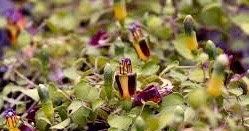Your Plant Bitch
The Creeping Fuchsia Seeds ~ Fuchsia Procumbens ~ Exotic ~ Unique ~ Fun ~ Bees ~ Butterflies ~ Beautiful Flowers
The Creeping Fuchsia Seeds ~ Fuchsia Procumbens ~ Exotic ~ Unique ~ Fun ~ Bees ~ Butterflies ~ Beautiful Flowers
Couldn't load pickup availability
Exotic Fuchsia, unlike most common types, is unique for its creeping habit. It is a deciduous creeping perennial, growing up to 2ft long, but only to a few inches in height. It slowly spreads and if allowed, can be used much like a ground cover. Bears pretty rainbow flowers followed by firm-fleshed, red edible berries!!!
~ Includes ~
~ 1 Seed.
~ Grow and Care Instructions.
🩷Creeping Fuchsia Grow and Care Instructions🩷
~ Grow Instructions ~
In the early spring, mix peat moss, potting soil, and vermiculite in an appropriate container for indoor seedlings. Spread the seeds across the mixture, press them down lightly, and cover them with a thin layer of potting soil. Cover the containers with clear, loose plastic and give them bright yet indirect light. Temperatures should be a consistent 75 degrees Fahrenheit. After the seeds sprout, remove the plastic cover for a few hours each day to let the seedlings grow hardy in lower humidity. When they have grown their first set of real leaves, they are ready to plant.
~ Care Instructions ~
Light
These plants thrive in conditions ranging from partial to complete shade. They prefer bright indirect light rather than direct sunlight when grown indoors.
Soil
Fuchsia plants prefer soil that is consistently moist but not soggy wet and has a high organic matter ratio. Also, the soil should be able to drain well. Before planting in-ground plants, amending the soil with peat moss or compost is recommended. Plants in containers only need a pot with good drainage and a regular peat-based potting mix.
Water
Fuchsias prefer moist but not soggy conditions. They thrive in humidity, so if you live somewhere dry, you may need to pay special attention to this to take care of your fuchsia plant.
Temperature and Humidity
Temperatures between 55 and 80 degrees Fahrenheit are best for fuchsias, but some heat-tolerant cultivars can keep their blooms up to 90 degrees Fahrenheit. There are also a few varieties of shrubs that can withstand freezing temperatures.
If you live in a dry climate, you may need to mist your fuchsia plants in order to keep them adequately moist.
It can be difficult to keep these plants healthy and happy indoors due to the low humidity levels. So keep a humidifier running nearby your fuchsia plants throughout the dry months of winter in order to prevent the air from becoming excessively dry.
Fertilizer
Fuchsias require frequent feedings of diluted liquid fertilizer throughout their blooming season. A mixture of fish emulsion and seaweed can be effective.
Pruning
Pruning a fuchsia plant on a regular basis can keep it blooming and vibrant. It is also acceptable to prune heavily. It will recover and be stronger as a result.
💜 Best Wishes, Your Plant Bitch (Quinn)
Share


















